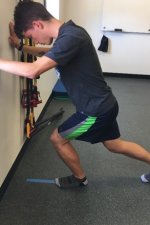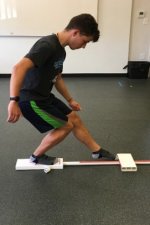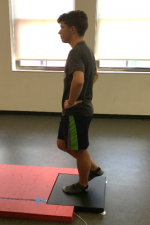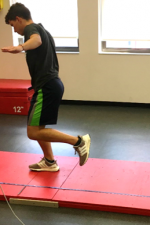It's Inauguration Day!
Congratulations, Matt vandenBerg, OWU's 17th President!
View details for Inauguration Day and stream the event live.
Congratulations, Matt vandenBerg, OWU's 17th President!
View details for Inauguration Day and stream the event live.

Shin splints are a generic label given to any pain in the medial tibia. The generality of the term shin splints creates some ambiguity, however, as pain in the medial tibia could arise from mild overuse or something more serious, such as stress fractures or muscle tears, leading to potentially misguided rehabilitation programs.
Shin pain accounts for 10-20% of all injuries sustained by runners and 60% of all overuse injuries in the leg. This could be due in part to the mechanically repetitive nature of running within track and field leading to constant, weight-bearing stress on the lower extremity. Athletes can miss practices and even full competitive seasons due to this injury depending on its severity. If symptoms are allowed to persist, more serious conditions could develop, such as stress reactions and fractures.
Despite the commonality of the injury, little concrete information concerning its etiology exists in the literature. The research lists numerous possible causes, or risk factors, but studies seem to contradict each other leading to confusion. Some of the risk factors mentioned are externally motivated, as they are performance-based in nature, or internally motivated, as they are anatomical or structural-based in nature. Risk factors can also vary from person to person making it difficult to determine the exact cause of pain.
This is a heavily researched topic, but little conclusive evidence exists regarding why the injury arises. Because of that, emphasis should be placed on prevention which comes from knowledge about risk factors.
The purpose of this research was to provide further empirical evidence clarifying the role of ankle range of motion (ROM), balance, single-leg (SL) hop performance, previous injury, and gender in the development of shin splints.
Understanding risk factors associated with medial tibia pain can help accurately identify those more at risk for developing shin pain. If pain is already present, understanding risk factors can allow the implementation of appropriate rehabilitation. The empirical data found can help clarify some of the discrepancies surrounding risk factors in the literature.
Research Questions
Results demonstrated that Division III female track and field athletes have had significantly more previous shin splint diagnoses and exhibited significant balance deficits when compared to their male counterparts. Whether this difference in diagnoses is due to structural (Q-angle) or bone density differences is unknown; but, the literature more heavily supports differences in bone density leading to the increased predisposition of females to shin splints. Results from this study also support SL balance deficits as a risk factor for shin splints given the link between greater female diagnoses and impaired balance when compared to males. Individuals presenting with shin splints were not found to differ in dorsiflexion ROM, Y-balance test (YBT) anterior reach, SL balance, or SL hop performances when compared to healthy individuals. Lastly, having a previous shin splint diagnosis was found to significantly increase chances of re-diagnosis by a factor of 17.3. This result supports previous findings that identified previous injury as a significant predictive factor for similar, future injuries. This data extends knowledge of the effects of previous injury on future injury and potential effects of gender on the development of shin splints.
Further research is needed to assess the true influence of SL balance on shin splint development. This study found potential links between balance performance and shin splint diagnoses through gender, but the two variables were not directly associated themselves. A larger sample size may be beneficial in detecting the possible relationship as a better ratio of individuals with and without shin splints may arise. It is also recommended to examine athletes outside of a single institution to increase diversity of the sample and generate more precise effect sizes. While no significance was found between shin splints and balance directly, balance should be included in shin splint screenings due to its relationship with ground reaction forces (GRF), impact forces, and reduced center of pressure (COP) excursion; increased GRF have been implicated in shin splint development and better balance has been shown to contribute to lower GRF, impact forces, and COP excursion. Both female gender and previous injury, along with SL balance should be considered when attempting to identify those more at risk for developing shin splints. Athletes who meet the at-risk criteria should be monitored closely throughout the season in order to catch early signs of injury that might otherwise go unnoticed. Preseason screening using gender, previous injury, and SL balance as measures is recommended for identifying at-risk individuals before injury onset occurs.
While this study utilized assessments sensitive enough to capture movement differences, it might be beneficial to use full motion analysis technology in order to observe structural and functional movement while running. This may provide deeper insight regarding movement differences in athletes presenting with shin splints and may help provide more clarity on anatomical or biomechanical risk factors. Furthermore, although no significance for dorsiflexion ROM was found in the present study, the preceding pilot study found near significance (p = .06) with a limited sample size (N=23). The literature is also still divided in its findings regarding the existence of the role of dorsiflexion ROM in shin splint development, so researchers should continue to examine it as a risk factor for shin splints.

Dorsiflexion ROM was measured in a weight-bearing lunge position using an inclinometer. Athletes drove their knee towards the wall until their heel came off the ground which is representative of maximum dorsiflexion being reached. Once the maximum angle was reached, an inclinometer was placed on the tibia to measure the achieved angle. Two trials were performed on each leg.

The Y-balance test (YBT) anterior reach measures dynamic postural stability and limb symmetry. Athletes placed the toes of their stance foot at the red line on the back box, and pushed the front box with their non-stance foot. The goal of the test is to push the box as far as you can while maintaining postural stability. For trials to count, athletes had to keep their back heel on the box and stand up in a controlled manner after reaching without touching the ground in any way. This process was repeated until two successful trials were performed on each leg.

SL balance also measures postural stability, but is able to capture more sensitive movement information. This test allowed analysis of center of pressure excursion (COP) - a measure of postural sway - and medial/lateral (ML) and anterior/posterior (AP) velocities - measures of how fast postural corrections were occurring. SL balance was performed both barefoot on the force plate and on an Airex pad on the force plate (not pictured). Athletes were allowed to tap the force plate for temporary balance aid, but trials were restarted if they stepped off the force plate at any point. One 30s trial was performed on each leg under each condition.

The SL hop test was used to measure limb symmetry in power production. Athletes stood at the front of a tape measure on the leg being tested. They were to jump off one foot and exhibit a controlled, single-leg landing for at least two seconds. If athletes lost their balance at the landing or stepped down immediately with their non-jumping leg, the trial was void. These procedures were repeated until three successful trials were achieved on each leg.